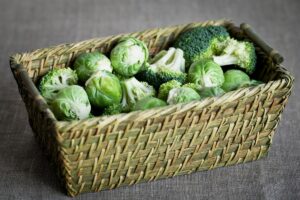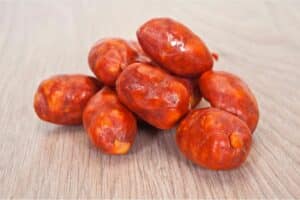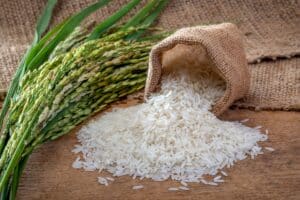Many of us have heard the phrase “fresh is best” about a wide range of foods and products. But is that always the case?
When we compare fresh ginger with ground ginger, there are a lot of things to consider. Both fresh ginger and ground ginger have a set of pros and cons as well as best uses that we need to keep in mind.
And because ginger is such a widely-used and versatile ingredient in the kitchen, it’s a good idea to learn about its different forms.
Let’s look at the ingredient ginger and see if we can determine the differences and best uses for both forms.
Difference Between Fresh Ginger and Ground
The main difference between fresh ginger and ground ginger is its form. Ground ginger is a fine powder held in a spice container, while fresh ginger is a jagged root with a tan peel and yellow flesh.
Of course, there are more differences between dry ginger vs. fresh ginger than just its form. Consider these additional distinctive properties:
- Appearance: As noted above, fresh ginger is a whole root vegetable, while ground ginger is a dried, powder form of the veggie.
- Flavor: Fresh ginger has a more potent flavor, but it takes much less ground ginger to achieve a similar taste.
- Shelf life: Ground ginger stays good much longer than fresh ginger.
- Best Uses: Fresh ginger is best for savory recipes, while ground ginger works well in baking.
We’ll look at some of these details below.
Fresh Ginger vs Ground Comparison Table
| Type of Ginger | Appearance | Flavor | Uses | Shelf Life |
| Fresh Ginger | A curved, jagged root with brown skin and yellow flesh | Refreshing, peppery, and butter with a musky aroma | Mainly cooking savory dishes | One month in the fridge when uncut |
| Ground Ginger | A fine, yellow-brown powder stored in spice jars | Peppery and sweet with a milder taste | Mostly for baking sweets and as a substitute for fresh ginger | Two to three years in an airtight container |
Can You Substitute Ground Ginger for Fresh Ginger?
In short, you can substitute ground ginger for fresh ginger in a dish. However, it’s important to understand that the differences between these two ingredients can impact your recipe and the dish as a whole.
It’s critical to remember that one tablespoon of freshly grated ginger is equal to just a one-eighth teaspoon of ground ginger. So, if you’re using ground ginger to replace fresh ginger in a recipe, you must cut down the measurement significantly.
Otherwise, your dish could end up far too pungent.
You can also substitute fresh ginger for ground ginger, but this can also affect your dish. Fresh ginger has much more moisture, whereas ground ginger is dry and fine.
Therefore, when using fresh ginger, your final product may have a different texture than you desired.
And because of the difference in measurements that we pointed out above, you will likely need to add more fresh ginger to a dish to achieve the flavor you’re looking for.
Overall, it’s better to substitute ground ginger for fresh ginger than to do so the other way around. This is especially true if you’re making baked goods like gingerbread, cookies, or pie; ground ginger is best.
Finally, ground ginger mixes better with liquids. You can use fresh ginger to make tea or add flavor to other drinks, but fresh ginger will mix more completely.
What is Fresh Ginger?
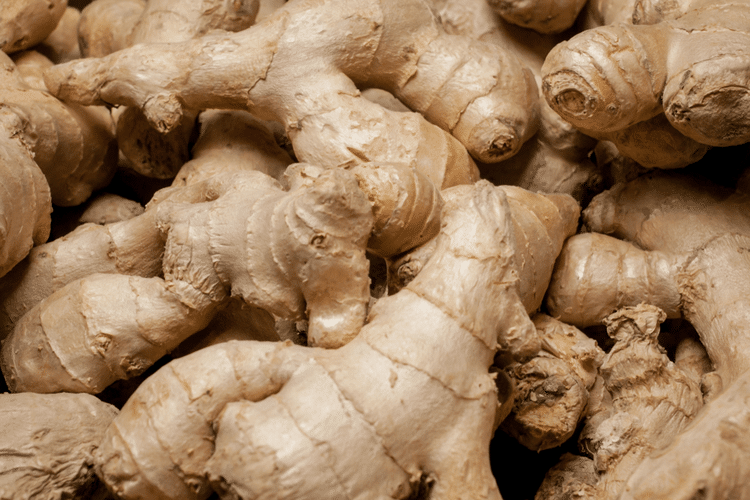
Though you wouldn’t know from its appearance, the ginger root comes from a flowering plant native to Southeast Asia. The pale yellow flowers aren’t impressive, but they have coveted the roots of this plant since ancient times.
So ancient that we can trace this root back to 1st-century trade deals between the ancient Romans and India.
As we know, the fresh ginger product we use today is a root. It has a lumpy, shapeless body covered in tan skin. The flesh is wet and juicy and is easily chopped, shredded, pressed, and minced for a wide range of dishes and cooking.
How to Use Fresh Ginger
Because fresh ginger has such a unique sweet-peppery flavor, it also has a wide range of uses. But after taking one look at this strange-looking vegetable, you may be wondering how on earth you’re supposed to use it.
First things first, be sure to pick out good roots at the grocery store. A healthy root should have a nice tan color with little to no defects. The skin should be dry, and the body should feel firm when you squeeze it.
If a ginger root is wet, squishy, burnished, shriveled, discolored, or moldy, leave it on the shelf. It also helps to pick a ginger root that has large pieces and few to no small, narrow limbs.
As mentioned above, you can slice, chop, mince, and even juice the ginger root. Most of today’s savory cooking recipes call for chopped or minced ginger. Fresh ginger is great in:
- Soups
- Meat/chicken dishes
- Vegetables
- Juice/smoothies
- Tea
- Salad dressings
Additionally, fresh ginger offers several health benefits, so many people like to add it to everyday drinks and meals to boost the immune system – among other efforts.
For starters, the ginger root contains gingerol. This powerful component is the main bioactive compound in the root and is known for its medicinal properties.
Because ginger contains gingerol, it’s ideal for treating issues with nausea, digestion, and oxidative stress.
Ginger may also be helpful in those looking to lose weight. The science isn’t yet exact on this, but some studies present promising evidence.
Fresh ginger may also help with arthritis, high blood sugar, heart disease, and chronic indigestion. And finally, it can give your immune system a good boost.
What is Ground Ginger?
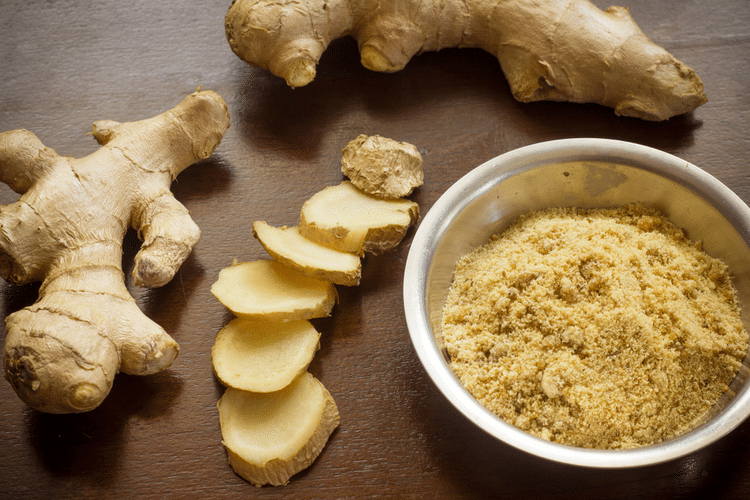
If you didn’t know that ground ginger came from the ginger root, you probably wouldn’t be able to put two and two together simply by sight. Ground ginger is the dried and powdered form of this vegetable and looks nothing like its original form.
Because ancient peoples transported ginger on long journeys over oceans, it’s easy to assume why they began drying the product; ground ginger has a much longer shelf life.
But the farming process for fresh ginger and ground ginger is slightly different.
Ginger that will be sold in its original form is generally harvested between four and five months after planting. Ginger designated to the drying process needs to mature longer in the ground and won’t get harvested until eight to ten months after planting.
After it gets harvested, the ginger gets soaked, cleaned, and peeled. It then dries out in a specialized machine and is ground down into a fine powder.
How to Use Ground Ginger
While you can certainly use ground ginger in cooking and savory dishes – even as a substitute for fresh ginger – people most frequently use it in baking. Ground ginger is a very versatile spice that’s both sweet and pungent.
Here’s a quick glimpse at what you can make using ground ginger:
- Bread
- Pastries
- Pies
- Muffins/cakes
- Fruit tarts
Ground ginger is ideal for these types of recipes simply because fresh ginger can alter the texture of one of these sweet, dense treats. Ground ginger allows you to get all of the flavors without the risk of an odd texture.
But ground ginger still works well in savory dishes as well. And just like fresh ginger, ground ginger comes with some helpful health benefits.
The powder may lose some of its gingerol during the drying process, but it maintains essentially the same nutritional value as fresh ginger.
You can even learn to make your own dried ginger at home using the ginger root.
After washing off your ginger root, use a peeler to remove the skin. Some people also prefer to use a spoon to scrape off the skin.
Cut your ginger into thin slices and dry them either by baking them or placing them in a dehydrator. Times will vary depending on the amount of ginger and the thickness of your slices, so keep an eye on them until they are completely dry.
Grind up the dried pieces of ginger using a food processor. You can also use a blender if you don’t have a processor. Blend until the slices become a very fine powder, then store it in an airtight container for up to three years.
Final Thoughts
There are not a lot of ingredients that can jump from savory meals to sweet baked goods to tea all in the blink of an eye, but both fresh and ground ginger can accomplish this feat.
Ginger is the perfect ingredient to spice up a bland dish or add some bold flavor to your favorite holiday treat.
And while fresh ginger looks, feels, and even tastes slightly different from ground ginger, the two are usually interchangeable. So, when you only have one on hand, you can still do quite a bit in the kitchen.

